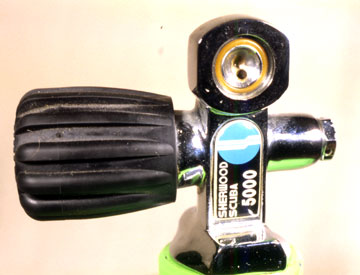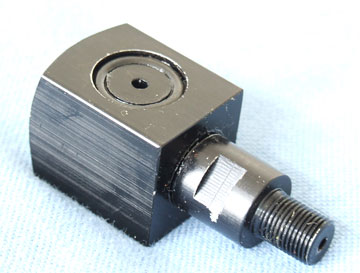The 3000 psi hand pump - by B.B. Pelletier
As more shooters turn to PCPs, there is an increased demand for the high-pressure hand pump. Once you overcome the shock of discovering that it's really possible to pump 3,000 psi by hand, the pump becomes quite fascinating for many shooters. To help you make your decision, let's look at some pump facts that aren't so obvious.
Is it REALLY possible to pump 3,000 psi?
It is, but like most things, there is more to it. After the pump reaches 1,500 psi, it starts resisting a little. At 2,000 psi, the resistance increases and at 2,500 psi I can no longer comfortably work the pump with one hand. At 2,700 psi, the resistance becomes so great that I start to use the entire weight of my body to push the handle down, rather than just the strength of my arms. By leaning all my weight on the pump handle and bending at the knees, my whole body pumps for me. Now, I'm fairly large and I'm fit, so those numbers will be different for others. Here's some advice that was given to me when I bought my first pump about ten years ago. You must weigh at least 130 pounds to pump the hand pump up to 3,000 psi. It will become easier as your weight increases, because you have more weight to push down the handle.
That handle works in both directions!
Although the hand pump looks like a bicycle pump, the similarity ends there. The high-pressure hand pump is actually three pumping units tucked into a single package. It compresses air on the upstroke, too. On the downstroke, it does its final compression, which is where the resistance becomes the heaviest. Take your time going in both directions because the air holes inside aren't very large. You'll hear the pump start to wheeze, which is to remind you to go slow. Allow at least a full second at either end of the pump stroke for all the air to flow. And, for gosh sakes, pump the handle ALL THE WAY down on every stroke! The last inch of travel is where all the work gets done.
Not all pumps are the same!
If you're new to airguns or just to precharged pneumatics, it might surprise you to learn there have been at least seven major pumps in the past 10 years - and many variations of most of them. Do not think for a moment that they're all alike, or that when you buy one you get everything you need to fill your airgun.
Pumps for 10-meter airguns
I've written enough on 10-meter target airguns that you should be familiar with them. From yesterday's post about airgun competition, you now know 10-meter competition is the largest single group of competitive airgunners in the world, comprising over a million shooters worldwide. So, when you buy a pump from a 10-meter dealer, it doesn't look like one you'll buy from Pyramyd Air. In its base, there is a large hole threaded in the DIN pattern. DIN stands for Deutsches Institut für Normung - the German institute for standards. Some scuba tanks have DIN valves, which are valves with large threaded holes, for equipment to screw into. There is a 200 bar DIN hole for 3,000 psi equipment and a 300 bar DIN for 4,500 psi equipment (psi figures rounded up for simplicity). The diameter and threads of both holes are the same, but the 300 bar DIN hole is deeper.
All 10-meter precharged airguns are set up for DIN filling equipment, and that includes the pumps. When you buy that second-hand pump from somebody, it may come with a DIN hole in the base rather than the 1/8" BSPP hole you were expecting! (The hole through the fitting is one-eighth inch in diameter and the threads are British Standard Pipe Parallel threads.)

Pump on the left has a DIN hole in its base. Pump on the right has two 1/8" BSPP holes (one is for the gauge that is missing). As you can see, it matters which one you have!

Say hello to the K-valve on a scuba tank. This is a common type of scuba valve - though certainly not the only one!

This adapter screws into a 1/8" BSPP hole to give pump owners a K-valve. There was also one that fit a DIN hole. Not currently available.
If the adapter for your airgun is for a scuba tank K-valve, that's what it has to fit. But hand pumps don't have K-valves on them! A few years ago, an airgun dealer made up a few hundred adapters that screwed into most pumps (the ones that have a 1/8" BSPP threaded hole in the base), giving pump users a K-valve of their own! He also made up some to fit pumps with DIN holes in their bases. This is a great item, though not currently offered by anyone, as far as I know.
Two quick ways to DESTROY a hand pump!
No. 1: For immediate destruction, disassemble your pump! The magic leaks out the moment the first fitting is loosened.
No. 2: This takes several pumping sessions, but is easy to do in less than one month. Don't allow your pump to cool down for 15 minutes after every five minutes of pumping! You will burn the high-temperature packing (the deepest seal in the pump!) and probably crack the brass fitting that holds it. The outward symptoms are a pump handle that refuses to stay down.
I own three hand pumps and am testing a fourth one on long-term loan. All the pumps I own are at least three years old and the oldest is 10, and none has ever needed maintenance. I use scuba tanks most of the time, but when my tank is low I reach for a hand pump!



